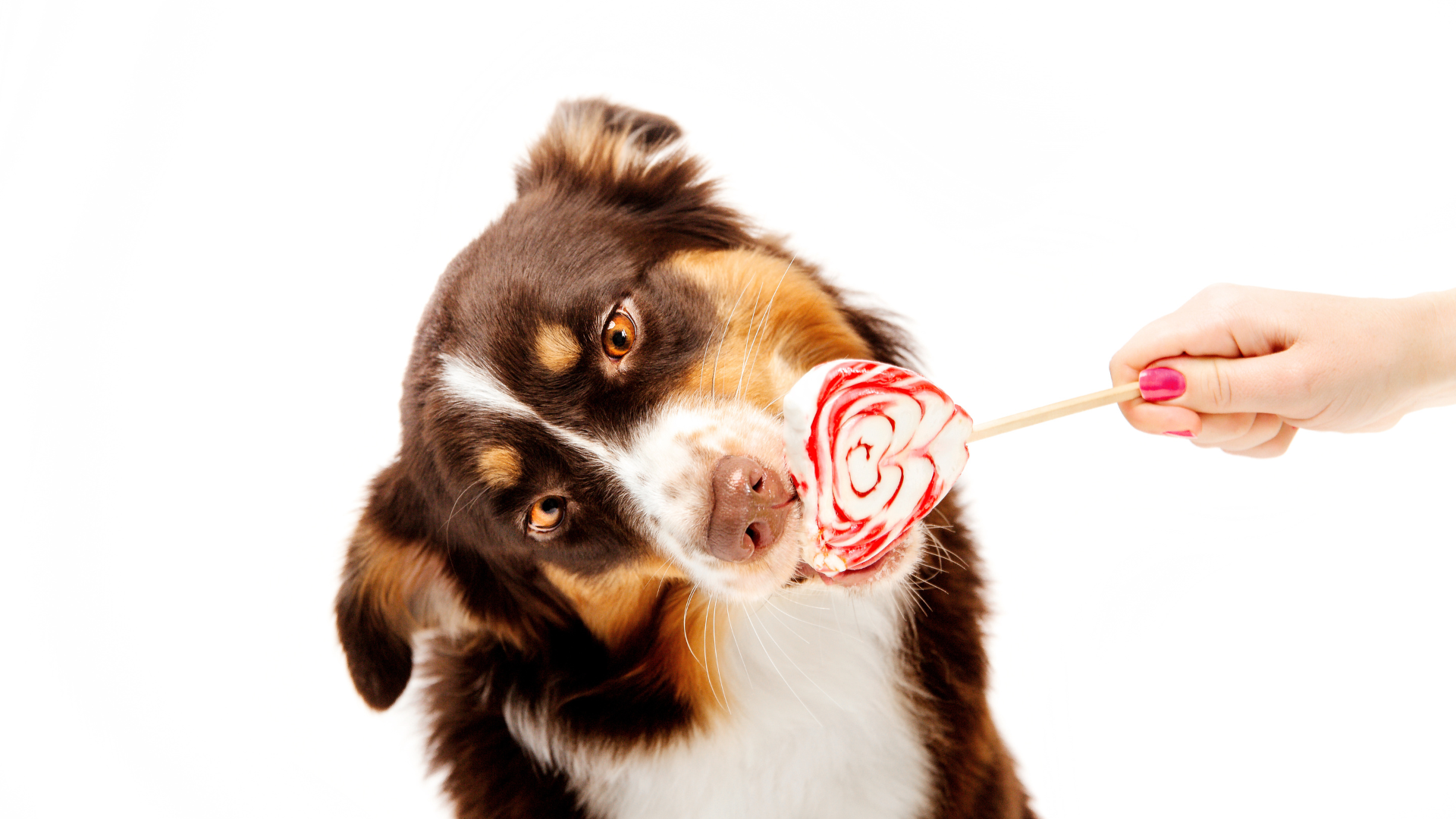Candy is a popular treat that many people enjoy, but what about our furry friends? Dogs are known for their love of treats, and many pet owners wonder if it's safe to give their dogs candy. While some types of candy can be harmful to dogs, there are now options available specifically designed for our four-legged companions.

Dog-friendly candy is becoming increasingly popular, and for good reason. These treats are made with ingredients that are safe for dogs to consume, so pet owners can feel confident in giving them as an occasional treat. They come in a variety of flavors and textures, from chewy to crunchy, and can be a fun way to reward good behavior or simply show your dog some love.
However, it's important to note that even dog-friendly candy should be given in moderation. As with any treat, too much can lead to weight gain and other health issues. It's also important to read the ingredients list carefully to ensure that there are no harmful additives or preservatives. With that said, dog-friendly candy can be a great way to indulge your pup's sweet tooth while keeping them safe and healthy.

Understanding Candy Toxicity in Dogs
When it comes to candy, dogs have a sweet tooth just like humans. However, not all candy is safe for dogs to consume. It's important for dog owners to understand the potential dangers of candy toxicity in dogs to keep their furry friends safe.
The Dangers of Chocolate
Chocolate is one of the most well-known toxic substances for dogs. It contains a compound called theobromine, which dogs are unable to metabolize effectively. Theobromine can cause vomiting, diarrhea, seizures, and even death in dogs. The darker the chocolate, the more theobromine it contains, making it more toxic for dogs.
Xylitol and Sugar Substitutes
Xylitol is a sugar substitute commonly found in sugar-free candy and gum. It can cause a rapid insulin release in dogs, leading to hypoglycemia (low blood sugar). Symptoms of xylitol poisoning in dogs include vomiting, loss of coordination, seizures, and liver failure.
Other sugar substitutes, such as erythritol and stevia, are generally considered safe for dogs in small amounts. However, it's important to always check the ingredient list and consult with a veterinarian before giving any candy or treats to your dog.
Other Toxic Ingredients
In addition to chocolate and sugar substitutes, other ingredients commonly found in candy can be toxic to dogs. Raisins and grapes, for example, can cause kidney failure in dogs. Nuts, especially macadamia nuts, can cause vomiting, tremors, and hyperthermia in dogs.
Artificial sweeteners such as sorbitol and mannitol can also cause gastrointestinal upset in dogs. It's important to always read the ingredient list and avoid giving any candy or treats to your dog that contain toxic ingredients.
Overall, while candy can be a tasty treat for dogs, it's important for owners to be aware of the potential dangers of candy toxicity. By being knowledgeable about the ingredients in candy and keeping it out of reach of pets, owners can help keep their furry friends safe and healthy.
Health Risks Associated with Candy
Candy may be a tasty treat for humans, but it can be harmful to dogs. Ingesting candy can lead to a variety of health risks, both immediate and long-term. It is important for dog owners to be aware of these risks and take steps to prevent their furry friends from consuming candy.
Immediate Health Concerns
Consuming candy can cause immediate health concerns for dogs. Some of the most common issues include vomiting, diarrhea, and seizures. These symptoms can be caused by the high sugar content in candy, which can upset a dog's stomach and lead to dehydration.
In addition to these symptoms, candy can also cause poisoning in dogs. Certain types of candy, such as those containing chocolate or xylitol, can be toxic to dogs and cause serious health problems. Chocolate contains theobromine, which can cause vomiting, diarrhea, tremors, seizures, and even death in dogs. Xylitol, a sugar substitute found in some sugar-free candies, can cause hypoglycemia, seizures, liver failure, and even death in dogs.
Long-Term Health Issues
Consuming candy on a regular basis can also lead to long-term health issues for dogs. One of the most common issues is obesity. Candy is high in calories and can cause dogs to gain weight quickly. This can lead to a variety of health problems, including diabetes, heart disease, and joint problems.
In addition to obesity, consuming candy can also lead to pancreatitis in dogs. Pancreatitis is a condition in which the pancreas becomes inflamed, leading to abdominal pain, vomiting, and diarrhea. It can be caused by consuming high-fat foods, such as candy.
Overall, it is important for dog owners to be aware of the health risks associated with candy. By keeping candy out of reach and providing dogs with healthy treats, owners can help prevent their furry friends from experiencing these health problems.

Recognizing Symptoms of Candy Poisoning
Candies are sweet treats that humans love, but they can be dangerous for dogs. Dogs have a different digestive system than humans, and certain ingredients found in candies can cause severe health problems for them. If you suspect that your dog has ingested candy, it is important to recognize the symptoms of candy poisoning and seek immediate veterinary care.
Clinical Signs of Chocolate Toxicity
Chocolate is one of the most common candies that dogs consume, and it contains a substance called theobromine that can be toxic to dogs. The severity of chocolate toxicity depends on the amount and type of chocolate consumed, as well as the size and weight of the dog.
Clinical signs of chocolate toxicity in dogs include vomiting, diarrhea, restlessness, increased urination, and seizures. The severity of symptoms may vary depending on the amount of chocolate ingested and the dog's sensitivity to theobromine.
Symptoms of Xylitol Poisoning
Xylitol is a sugar substitute commonly found in sugar-free candies, gum, and baked goods. It is safe for humans but can be extremely toxic to dogs. Xylitol can cause a rapid release of insulin, leading to hypoglycemia (low blood sugar) and liver failure.
Symptoms of xylitol poisoning in dogs include vomiting, loss of coordination, seizures, and coma. If you suspect that your dog has ingested xylitol, seek immediate veterinary care.
In conclusion, it is essential to keep candies and other sweet treats out of reach of dogs. If you suspect that your dog has ingested candy, it is important to recognize the symptoms of candy poisoning and seek immediate veterinary care. Early intervention can prevent serious health problems and save your dog's life.
Preventive Measures and Safety Tips

Safe Storage and Handling
When it comes to candy for dogs, safe storage and handling are crucial to avoid any accidents. It is important to keep all sweets out of reach from dogs, especially during Halloween when candy is abundant. Dogs have a keen sense of smell and can easily find hidden treats. Therefore, it is recommended to store all candy in a secure place where dogs cannot access them, such as a high cabinet or a locked pantry.
In addition, it is essential to dispose of candy wrappers properly. Dogs may accidentally ingest wrappers, which can cause choking or intestinal blockage. Therefore, it is important to dispose of wrappers in a trash can with a secure lid.
Educating Family and Guests
Educating family and guests about the dangers of candy for dogs is crucial to prevent accidental ingestion. It is important to inform them about the potential risks of chocolate poisoning and other health issues that can arise from dogs eating candy. Moreover, it is important to instruct them to keep all candy out of reach from dogs and to dispose of wrappers properly.
Alternatives to Candy for Dogs
To satisfy a dog's sweet tooth without risking their health, there are many dog-safe treats available on the market. These treats are specifically designed for dogs and are free from harmful ingredients such as chocolate and xylitol. Some examples of dog-safe treats include:
- Carrots
- Apples
- Bananas
- Sweet potatoes
- Peanut butter (without xylitol)
In conclusion, preventive measures and safety tips are essential when it comes to candy for dogs. Safe storage and handling, educating family and guests, and offering dog-safe treats are all important steps to ensure a dog's health and well-being. By following these tips, dog owners can enjoy Halloween without putting their furry friends at risk.
Emergency Response to Candy Ingestion
First Aid for Accidental Ingestion
If a dog accidentally ingests candy, it is important to act quickly. The first step is to remove any remaining candy from the dog's mouth. If the candy is still in the dog's mouth, try to remove it by using a finger or a soft, blunt object. Do not use any sharp objects, as they can cause further damage to the dog's mouth or throat.
Next, provide the dog with plenty of water to help flush out any remaining candy in their system. If the dog is showing signs of distress, such as vomiting or diarrhea, it is important to monitor them closely and seek veterinary attention if necessary.
When to Contact a Veterinarian
If a dog has ingested a large amount of candy or is showing signs of poisoning, it is important to contact a veterinarian immediately. Signs of poisoning may include vomiting, diarrhea, lethargy, loss of appetite, and seizures.
It is also important to contact a veterinarian if the dog has ingested any candy that contains xylitol, a sugar substitute that can be fatal to dogs. Xylitol can cause a rapid insulin release, leading to hypoglycemia, seizures, and even death.
Treatment Options
If a dog has ingested candy containing xylitol, the veterinarian may administer activated charcoal to help absorb the toxin and prevent it from being absorbed into the bloodstream. The dog may also need to be hospitalized for monitoring and supportive care.
In less severe cases, the veterinarian may recommend monitoring the dog at home and providing supportive care, such as fluids and anti-nausea medication.
Overall, it is important to be aware of the risks associated with candy ingestion in dogs and to take appropriate action if necessary. Contacting a veterinarian as soon as possible can help prevent serious and potentially fatal conditions.

Creating a Dog-Friendly Diet
When it comes to feeding your furry friend, it's important to keep in mind that dogs have different nutritional needs than humans. While it may be tempting to give your dog a piece of candy or a sugary treat, it's important to remember that too much sugar can be harmful to their health. Here are some tips for creating a dog-friendly diet.
Healthy Treat Alternatives
Instead of giving your dog candy or other sugary treats, there are plenty of healthy alternatives that can satisfy their sweet tooth. Some examples include:
- Carrots: These crunchy veggies are low in calories and high in fiber, making them a great snack for dogs.
- Apples: Apples are a good source of vitamins and minerals, and many dogs enjoy the taste.
- Peanut butter: As long as it doesn't contain xylitol (a sweetener that is toxic to dogs), peanut butter can be a tasty treat for dogs.
- Homemade dog treats: Making your own dog treats allows you to control the ingredients and ensure that they are healthy for your pet.
Understanding Canine Nutrition
In addition to choosing healthy treats, it's important to understand the basics of canine nutrition. Dogs require a balanced diet that includes protein, fat, and carbohydrates. They also need certain vitamins and minerals to stay healthy.
While some human foods are safe for dogs to eat, others can be harmful or even toxic. For example, chocolate, grapes, and onions can all be dangerous for dogs. It's important to do your research and make sure that any food you give your dog is safe for them to eat.
Finally, it's important to remember that every dog is different. Some dogs may have special dietary needs due to health conditions or allergies. If you have any concerns about your dog's diet, it's always a good idea to consult with your veterinarian.
By following these tips and choosing healthy, dog-safe treats, you can help ensure that your furry friend stays happy and healthy.
Conclusion

In conclusion, dog-friendly candies can be a delicious and enjoyable way to reward our furry companions. However, it's essential to prioritize their health and well-being by selecting treats made from natural ingredients, avoiding excessive sugar consumption, and practicing moderation in treat giving. By making informed choices and monitoring their intake, we can ensure that our dogs enjoy tasty treats while maintaining optimal health.
Frequently Asked Questions
- What should I do if my dog consumes chocolate?
- If your dog consumes chocolate, you should contact your veterinarian immediately. Chocolate contains theobromine, which can be toxic to dogs. The severity of the toxicity depends on the type and amount of chocolate consumed, as well as the size of the dog.
- Are there any safe sweet treats for dogs?
- Yes, there are many safe sweet treats for dogs, such as apples, bananas, and carrots. You can also find dog-friendly candy made with natural ingredients, such as carob or honey.
- How can I tell if my dog is suffering from candy ingestion?
- If your dog has ingested candy, they may exhibit symptoms such as vomiting, diarrhea, lethargy, or loss of appetite. If you notice any of these symptoms, it is important to contact your veterinarian for guidance.
- What are the symptoms of sugar overdose in dogs?
- Symptoms of sugar overdose in dogs may include vomiting, diarrhea, hyperactivity, and increased thirst and urination. In severe cases, it can lead to seizures or coma. It is important to monitor your dog's sugar intake and avoid giving them excessive amounts of candy or other sugary treats.
- Can dogs have candy with xylitol or other artificial sweeteners?
- No, dogs should not consume candy with xylitol or other artificial sweeteners. These sweeteners can be toxic to dogs and can cause symptoms such as vomiting, loss of coordination, and seizures.
- What are some homemade treat recipes suitable for dogs?
- There are many homemade treat recipes suitable for dogs, such as peanut butter and banana biscuits or pumpkin and oatmeal cookies. When making homemade treats, it is important to avoid ingredients that are toxic to dogs, such as chocolate or xylitol.




